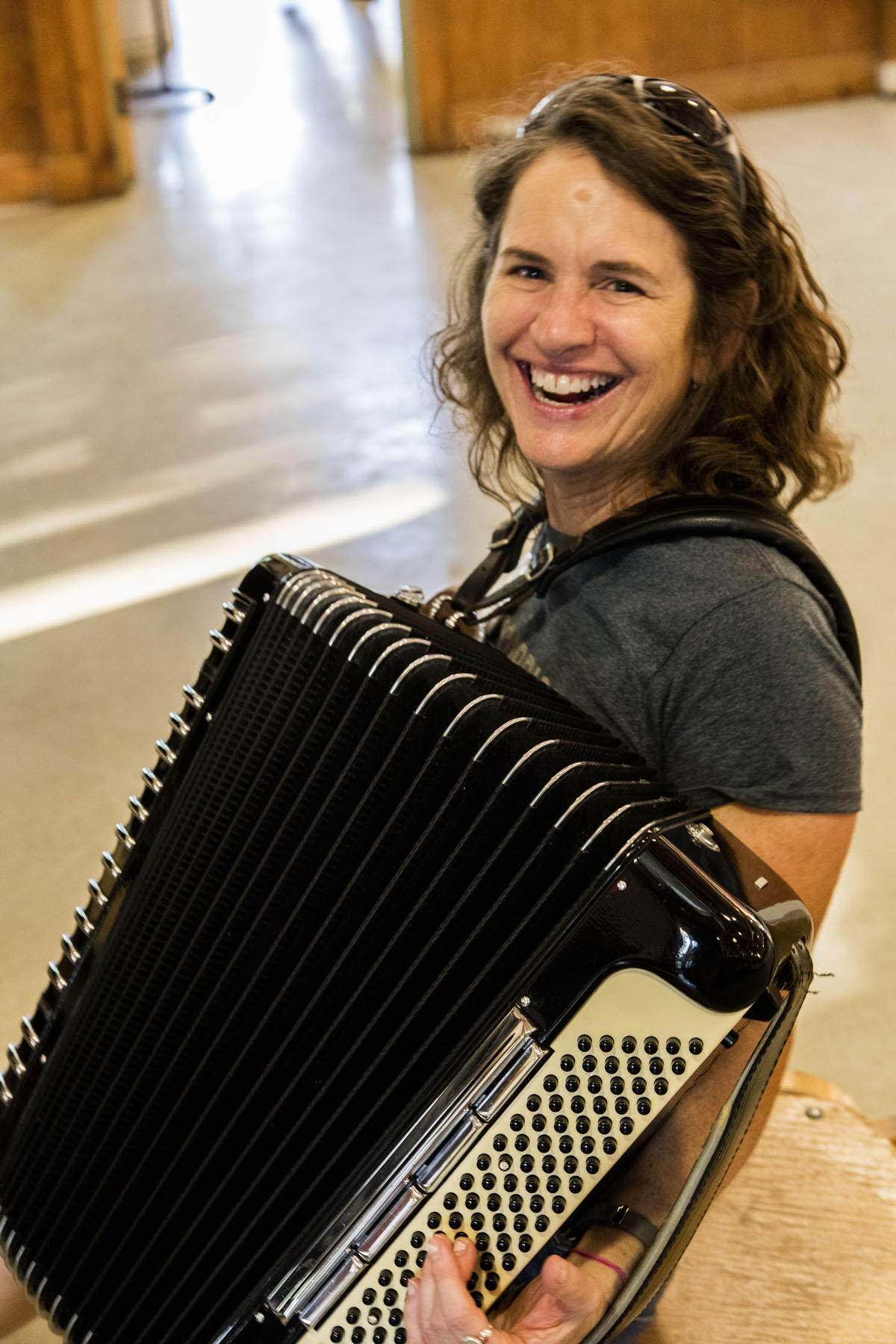 Karen Ann Sokohl - March 11, 2025 Karen Ann Sokohl - March 11, 2025
Karen loved accordions! Karen LOVED accordions and was passionate about accordion culture in all its forms and genres. What a fireball of energy, sunshine, and quirkiness! Karen was a joyful force—not to be reckoned with, but to be enjoyed. From the first moment you met her, you knew you’d found a fun friend for life. Her laughter could fill a room, a house, or an entire music festival.
Karen first attended NESI in 2016 and instantly fell in love with the Squeeze-In, returning several times and writing about her NESI experience in her blog, Accordion to Karen. She adored learning more about the accordion, sharpening her skills, and exploring all the genres of accordion music.
She was a great example of someone who was such a joyful newcomer to NESI and was so blown away by her experience at NESI that she would go on to encourage others to attend.
In Karen’s honor, the “Karen Sokohl Musical Artist Residency” will be established to nurture music and community—the things she cherished so deeply. Donate to LuckyStarFarmOzarks.com/donate.
|
|
Tony Hughes - 9/14/2021
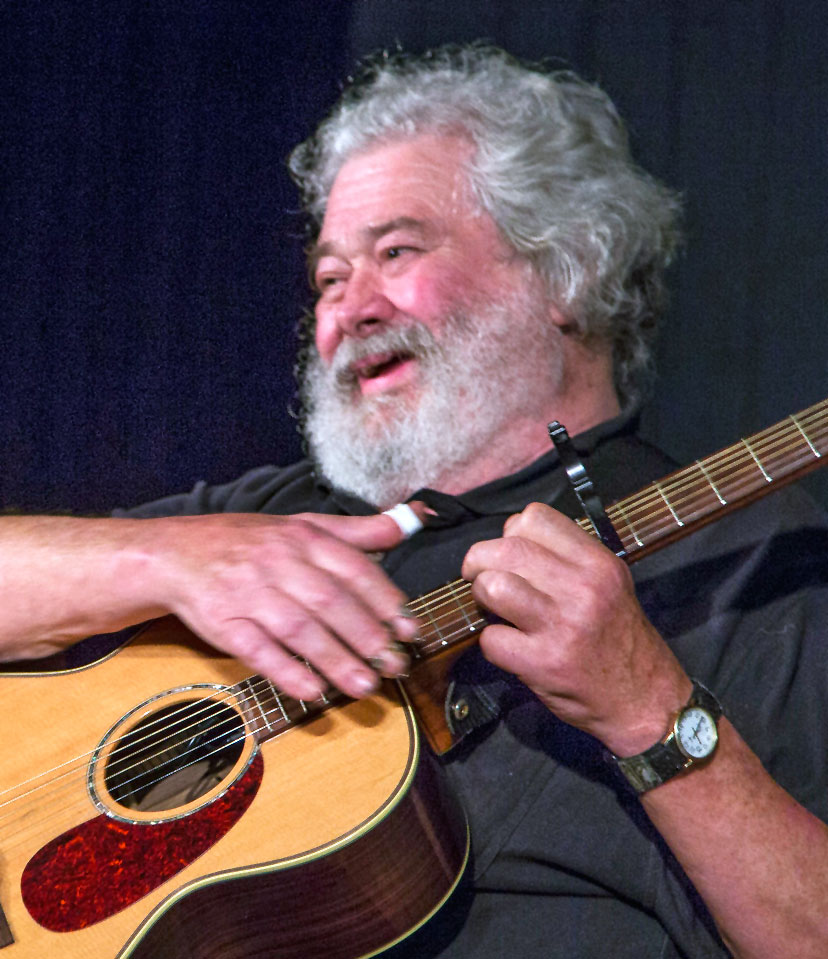 From the 2nd Squeeze-In at Bucksteep in 1991 to his last one at Chimney Corners in 2019, Tony could always be found on Friday and Saturday nights in the midst of a lively group, sharing his enormous repertoire of songs, some of which were astonishingly rude, crude, and bawdy. He had a phenomenal memory and, in his later years, loved learning the very long poems of Rudyard Kipling that had been set to tunes by Peter Bellamy. From the 2nd Squeeze-In at Bucksteep in 1991 to his last one at Chimney Corners in 2019, Tony could always be found on Friday and Saturday nights in the midst of a lively group, sharing his enormous repertoire of songs, some of which were astonishingly rude, crude, and bawdy. He had a phenomenal memory and, in his later years, loved learning the very long poems of Rudyard Kipling that had been set to tunes by Peter Bellamy.
One of his performing jobs for many years in the 1980s and 90s was a weekly gig at an English pub in Milford, NJ. Throughout the dinner seatings, he strolled from table to table, taking requests and was rarely unable to produce the wanted song. His instinctive ability to distract customers from a late-arriving entree were much appreciated by the wait staff as well as the owners.
Many of the traditional country songs he knew came from listening to the radio as he grew up in Augusta, Georgia. The time he spent in Nashville as an aspiring singer/songwriter added to his collection of classic country music as well as wonderful anecdotes about people in the Grand Ole Opry. He moved to Savannah around 1960 for a steady gig as a guitar-playing folksinger at The Boar’s Head, where he met an English concertina player and became interested in learning to play. It wasn’t until the late 1980s that he got an instrument, however, and started trying to figure it out on his own. A subscription to Concertina and Squeezebox magazine led him to the Squeeze-In, where he was a regular attendee and, eventually, became one of the organizers when the Button Box decided to hand it off.
Tony was a wonderful singer and focused most of his concertina-playing efforts on accompanying songs rather than playing tunes. He was always encouraging to others during those all-night sessions at the Squeeze-In. He influenced David Cornell to use his “silly operatic voice” (David’s description) to share his delightful repertoire of music hall songs and witty original work. Matt Heumann, too, became a confident vocal performer at least partly because of Tony’s assurance that everyone can and should sing. Although arthritis in Tony’s hands made both concertina and guitar playing difficult in his last years, he persevered and found ways to work around his limitations.
Songwriting was one of his abiding interests. Around 1968, a local Philadelphia television station started an early-morning children’s program called “The World Around Us.” Tony wrote and recorded the show’s theme song. Each of the daily shows had a topic, and the various musicians who appeared needed to find at least one song that fit. Tony often wrote a song instead of hunting for one. Probably the best known from that time was “The Little Blue Top.” It can be found in many places on the internet and is included in Rise Up Singing. It was used as the theme for the 1972 PBS video of the Philadelphia Folk Festival, in which Tony appeared in the Saturday night concert. He wrote and revised songs right on up to the day he died and left a large collection of works in progress.
Tony and I were married for more than 56 years, and we performed together through much of that time. One of his original works that we often did was “The Compost Song.” It embodies the indomitably joyful spirit that was among his most endearing qualities: I’ve lived the life I love, and that ain’t bad – remember me by the good times that we had. And so we will. |
|
Mike Knudsen - March 9, 2021 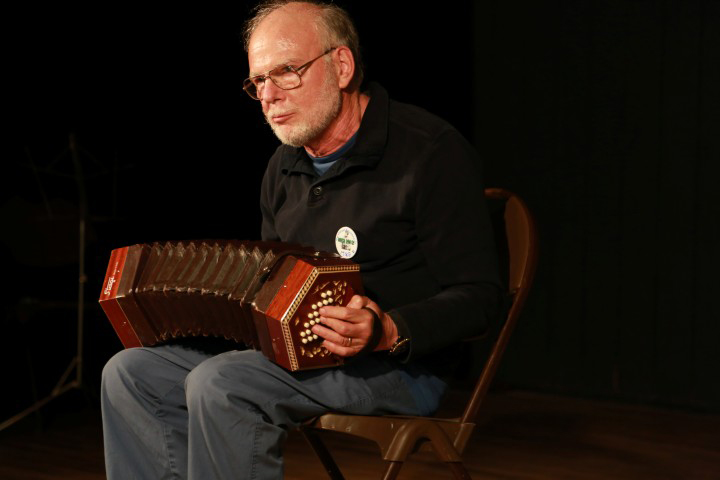
Mike Knudsen, PhD, was a retired computer scientist as well as an organist and composer. Late in life (2004), he began playing the Hayden duet concertina and began attending the NorthEast Squeeze-In a year later. That year, he arranged a piece of music for the concertina band at NESI. He continued attending NESI until 2015, when the progression of Parkinson’s disease made participating too difficult.
He was comfortable sharing his music even when Parkinson’s made his performance less than perfect and was a regular in the Saturday concert until he could no longer attend the event. He composed and performed many ragtime pieces on the concertina as well as tunes in other styles. Some of his tunes from NESI concerts include the Sandtrap Rag, The Lonely Coed Waltz, and The Cavern and the Temple.
Mike was a prolific contributor to the forums at concertina.net, using the screen name ragtimer. His many questions, opinions, and explanations were always interesting and are worth digging out at that site.
During the years Mike was coming to NESI, he lived in Maine with his wife, Chilton, who was the Bishop of Maine. They later moved to the Baltimore area, where he passed away. |
|
David Cornell - 5/23/2019
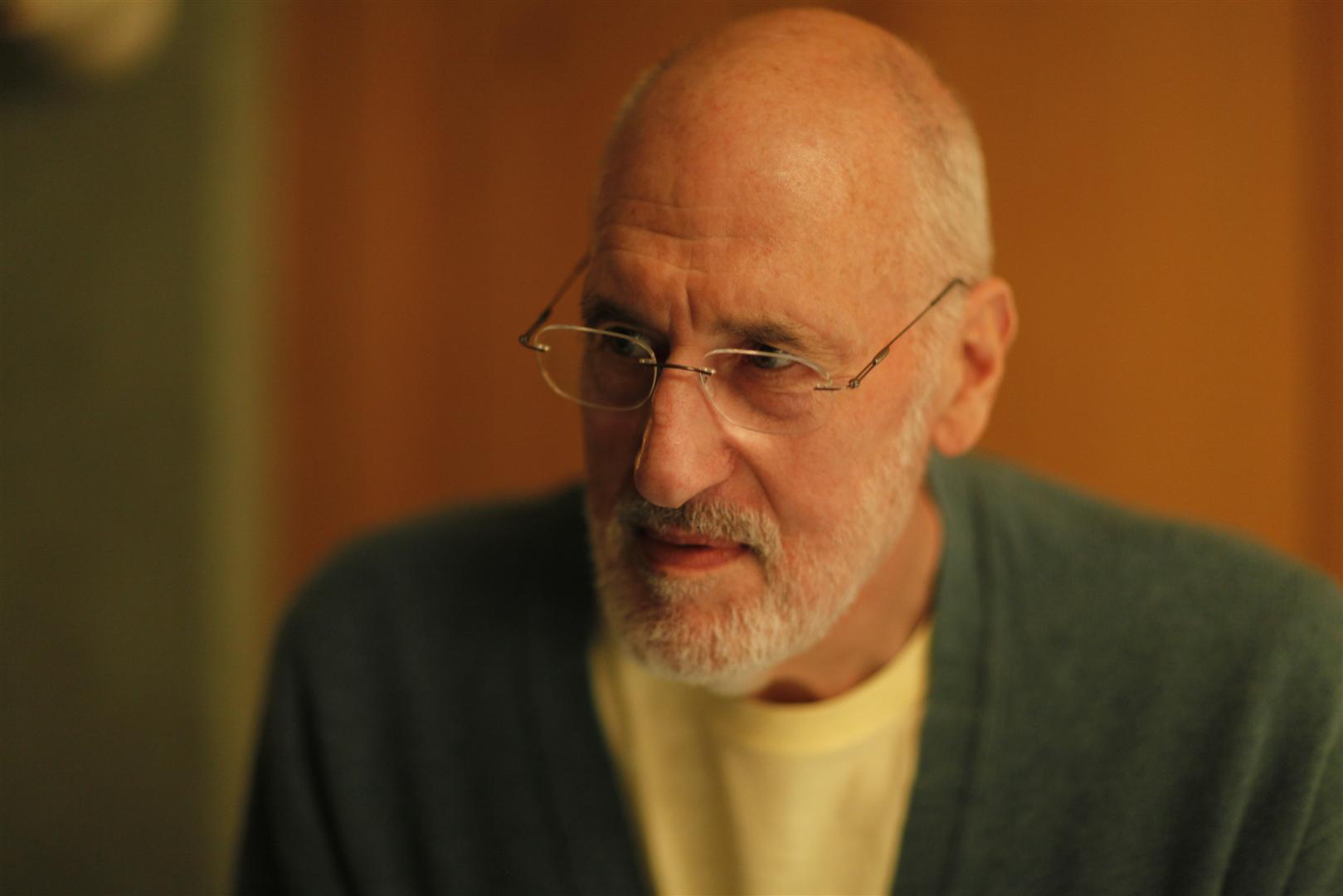 Golly, how to begin to speak of David? To say he was a kind, gracious, generous gentleman, the possessor of a legendary hoard of rare concertinas and a professional opera bass who mastered the (exceedingly difficult) McCann Duet and brought the traditional Brit Music Hall performance at an incomparable level to Bucksteep...that only begins to remember him. Every year at Bucksteep the premiere event was David's latest treasure, some pub or patter song, some witty wonder of double entendre (some self-composed)....always a glittering Faberge Egg of raconteur performance, music richly arranged and flawlessly performed, accompanied with wicked (or deadpan earnest) faces and his rich full bass inviting you to share in his delight and roll with laughter. Golly, how to begin to speak of David? To say he was a kind, gracious, generous gentleman, the possessor of a legendary hoard of rare concertinas and a professional opera bass who mastered the (exceedingly difficult) McCann Duet and brought the traditional Brit Music Hall performance at an incomparable level to Bucksteep...that only begins to remember him. Every year at Bucksteep the premiere event was David's latest treasure, some pub or patter song, some witty wonder of double entendre (some self-composed)....always a glittering Faberge Egg of raconteur performance, music richly arranged and flawlessly performed, accompanied with wicked (or deadpan earnest) faces and his rich full bass inviting you to share in his delight and roll with laughter.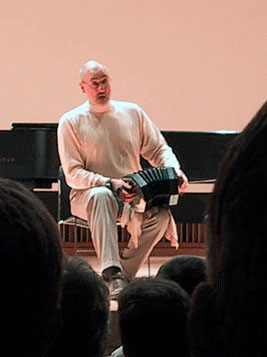
For all his excellence, he listened to all, was generously involved with everyone and lent himself to last minute group efforts...and remained encouraging even when the group's lesser musicians might have foundered on the Saturday night stage.
Alas, he stopped coming to NESI after 2007; when the initial inroad of Parkinson's made his music less than perfect, he bowed out at the top of his game. Unfortunately, the recordings of that glorious voice and his fingers dancing on the McCann are all but non-existant. There is one YouTube video of him on a folkie show, Horses Sing None of It. Also this recording of him performing Barker & Galipeau's Arnold the Armadillo. Some of his arrangements are online here. He is missed. |
|
Bob McQuillen - 2/6/2014
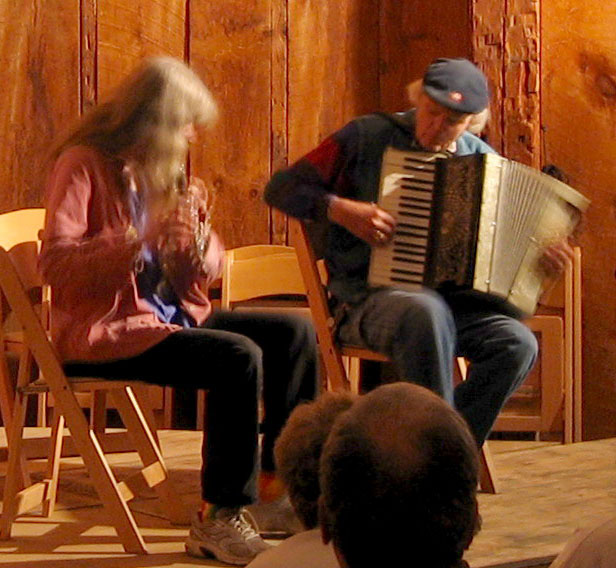 On the left is Bob knocking out For Ireland, I'd Tell Not Her Name with Deanna Stiles at the Saturday Night concert in 2008 (photo: Bob Beimers, Whistle at the end, Ken Sweeney). On the left is Bob knocking out For Ireland, I'd Tell Not Her Name with Deanna Stiles at the Saturday Night concert in 2008 (photo: Bob Beimers, Whistle at the end, Ken Sweeney).
How do you roundup the life of the grand old man of New England contra dance music? Ex Marine, ex-high school shop teacher, eagle-eyed Bob Mc Quillen,who touched, listened and gave to everyone he met. Who came to folk festivals in an old bread van with an upright acoustic piano in the back (and a fold down bunk above it)....then opened the doors and began to play backup to any and all...'Whatcha got to play, sonny?'. Bob memorably described playing music for contra dance "Like being paid to eat ice cream".
You can Google any number of tributes...here's one:
New Hampshire Public Radio, "Remembering Bob McQuillen, An "Old-Fashioned Contra Dance Piano Player"
and any number of videos.
The National Endowment for the Arts: Bob McQuillen, pianist and accordion player, was born near Boston, but his family moved to southwestern New Hampshire when he was a child. Although his grandfather played accordion and his father played the piano, McQuillen did not turn seriously to music until he returned from service as a Marine during World War II. Some friends took him to a local dance, and he became interested in playing the accordion. He continued his day job teaching industrial arts at the local high school in Peterborough, New Hampshire, but also began playing accordion and piano for dances throughout the region, working with the legendary contra dance caller and historian, Ralph Page. In 1973, McQuillen wrote his first tune, Scotty O'Neil, named for a student who died tragically. Since then, he has written more than 1,100 dance tunes. |
|
Howie Leifer - 1/5/2014
.jpg) Howie was a man of immense kindess and gentleness. He was a real listener, too, a rare thing. We miss him. On left, he is in 2010 (our last year at Bucksteep), singing his signature song, The Wreck of the Nancy Lee, at a late night pub sing....with a raucuous....and even occasionally in tune....accompaniment. Good fellowship all. Howie was a man of immense kindess and gentleness. He was a real listener, too, a rare thing. We miss him. On left, he is in 2010 (our last year at Bucksteep), singing his signature song, The Wreck of the Nancy Lee, at a late night pub sing....with a raucuous....and even occasionally in tune....accompaniment. Good fellowship all.
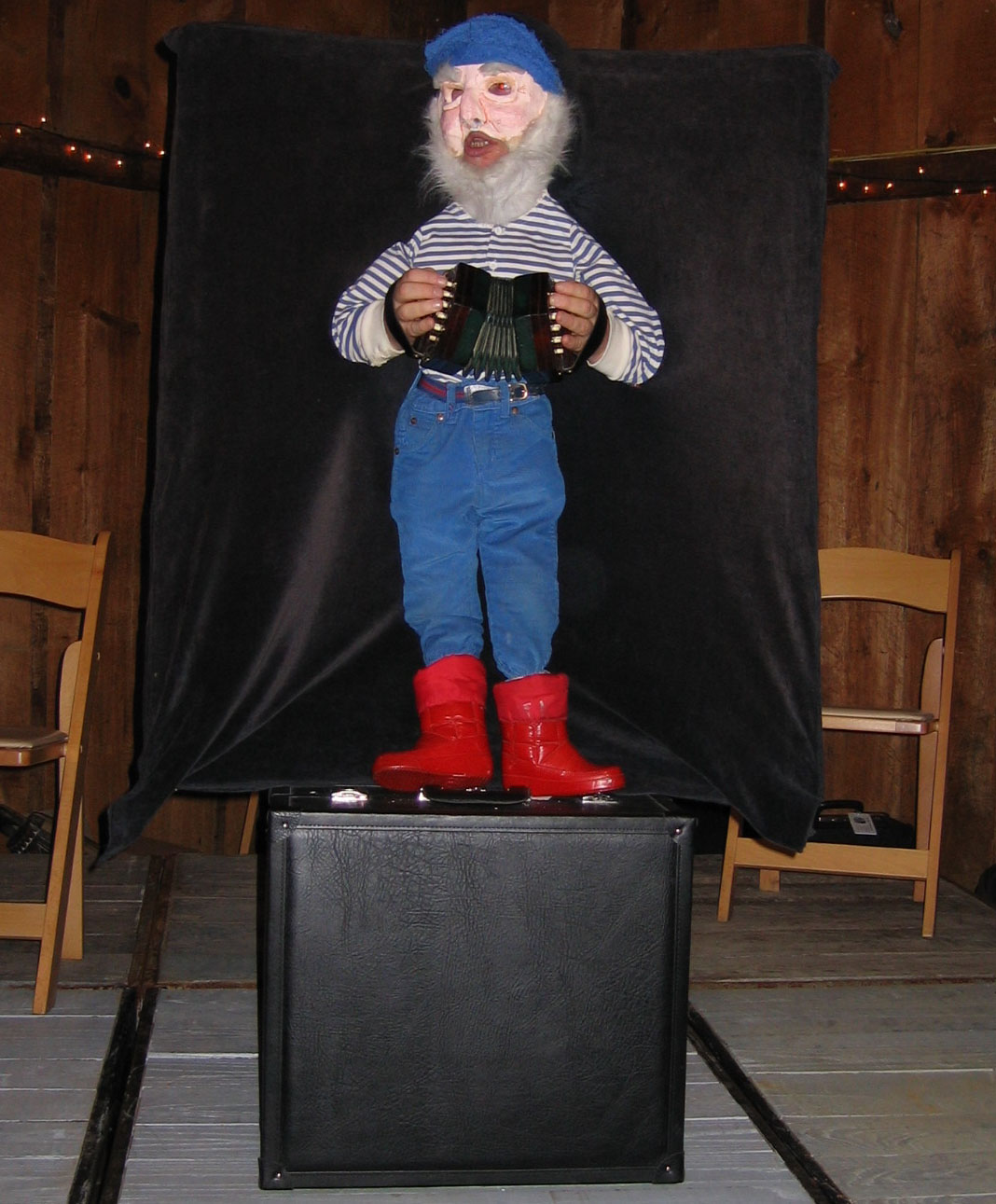 According to his brother Neil, his family started out on the lower East Side of Manhattan in the Vladek Housing Project and later moved to Queens. Howie had always been fascinated by the arts and found its expression in music and puppetry. By the time Howie was in his '30's, he was in San Francisco, teaching art at the French American International School in Haight Ashbury; he was remembered there on 3/11/14 at a service; click on the poster there for an enlarged version and a great picture of Howie 20 years ago with his puppets. Around 1999, his brother Neil, a famous photographer known for his many iconic Images, asked him to come back East to manage his photo archive. That was his work until he recently passed. According to his brother Neil, his family started out on the lower East Side of Manhattan in the Vladek Housing Project and later moved to Queens. Howie had always been fascinated by the arts and found its expression in music and puppetry. By the time Howie was in his '30's, he was in San Francisco, teaching art at the French American International School in Haight Ashbury; he was remembered there on 3/11/14 at a service; click on the poster there for an enlarged version and a great picture of Howie 20 years ago with his puppets. Around 1999, his brother Neil, a famous photographer known for his many iconic Images, asked him to come back East to manage his photo archive. That was his work until he recently passed.
On the right, is him playing and puppeteering simultaneously, Concert Night at Bucksteep! We paid a lot of attention to the man behind the curtain...chin, hands and music were all Howie.
In Tony's words, we are all hoping fondly for a heaven in which Howie can delight the angels with his droll humor and self effacing presence. |
|
Rich Morse - 3/2/2009
Rich founded the Button Box, perhaps the premiere free-reed establishment on the East Coast. When it was a going concern, he dreamed up the Squeeze-In, which became his special baby: a weekend for all those crazed people hooked on accordions, concertinas and the like....and ran it with imagination and enthusiasm for 20 some years. He was a guiding light for both....but so much more than a business man....he had such glee and run-go-see curiosity, He was a man who wanted to share his enthusiasm in the magic he found in the world. Here is part of his memorial from the Button Box website.
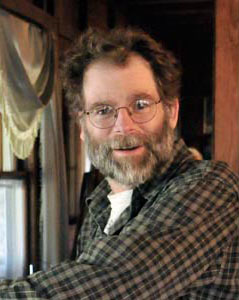 Rich Morse, founder and owner of The Button Box, died Monday, March 2, 2009, following the recurrence and rapid progression of melanoma, which he first developed in 1995. The end was quiet and peaceful, for which we are all grateful. Rich Morse, founder and owner of The Button Box, died Monday, March 2, 2009, following the recurrence and rapid progression of melanoma, which he first developed in 1995. The end was quiet and peaceful, for which we are all grateful.
Rich was born in Hawaii as Gordon Richard Morse, III. He came to the mainland to study at the Rhode Island School of Design and made New England his home thereafter. In his years as a practicing architect, his designs were a marvel, consistently displaying an exceptional sense of spatial relations and creative problem-solving. He was a longtime advocate for energy efficiency, incorporating conservation-minded principles into his plans for clients and practicing them in his private life. Rich riding his aging bike the mile between his house and The Button Box was a familiar sight; regardless of the weather, he was rarely willing to make such an inefficient trip using fossil fuel.
Rich started The Button Box in 1980, while living in a cabin in rural Wardsboro, Vermont. It was a sideline in the beginning, but his passion for free-reed instruments overtook his interest in architecture, and he eventually became a full-time "employee" of The Button Box. His capability as an innovative designer and his unlimited capacity for optimism were largely responsible for the development of R. Morse & Co. concertinas, and his abiding interest in all to do with concertinas made him something of a celebrity in the admittedly small niche of free-reed aficianados. In that role, he was unstintingly generous with his time, knowledge, and positive spirit.
Rich was in inveterate player of games, with an especial fondness for Go and Scrabble. He was a dedicated father, a talented photographer, an enthusiastic Morris dancer and contra dancer, and loved to play music and compose tunes.
He is survived by two sons, Geordie, of Sunderland, Massachusetts, and Kiva, of Phoenix, Arizona. His parents still live in Hawaii, and he has other close relatives in Hawaii and throughout the mainland.
Our last printed catalogue gave Rich's job description as "Guiding Light," and so he was, not only to us, but to others whose lives intersected with his. We at The Button Box will carry on, as will his friends and family, but we will miss him very much. Our thanks to all who have been in touch with us to express their sadness and share their memories of an exceptional human being.
There is now a website for memories, stories, and pictures of Rich. Anybody can edit it easily to add their own stories and pictures, and a few people have added stories already. Please take a look and feel free to add your own stories and pictures.
After Rich's passage, the Squeeze-In....and running it with the consuming imagination, glee and creativity that Rich had put in it....wasn't something that Button Box could do, so it asked the people of the Squeeze-In to take over NESI. Which we have done.
Rest in peace, Rich; thanks for all you did for so many, we carry it on and pay it forward. Photo: Kayti Sullivan at NESI 2007
|
|
|

 Karen Ann Sokohl - March 11, 2025
Karen Ann Sokohl - March 11, 2025 From the 2nd Squeeze-In at Bucksteep in 1991 to his last one at Chimney Corners in 2019, Tony could always be found on Friday and Saturday nights in the midst of a lively group, sharing his enormous repertoire of songs, some of which were astonishingly rude, crude, and bawdy. He had a phenomenal memory and, in his later years, loved learning the very long poems of Rudyard Kipling that had been set to tunes by Peter Bellamy.
From the 2nd Squeeze-In at Bucksteep in 1991 to his last one at Chimney Corners in 2019, Tony could always be found on Friday and Saturday nights in the midst of a lively group, sharing his enormous repertoire of songs, some of which were astonishingly rude, crude, and bawdy. He had a phenomenal memory and, in his later years, loved learning the very long poems of Rudyard Kipling that had been set to tunes by Peter Bellamy.

 On the left is Bob knocking out
On the left is Bob knocking out .jpg) Howie was a man of immense kindess and gentleness. He was a real listener, too, a rare thing. We miss him. On left, he is in 2010 (our last year at Bucksteep), singing his signature song, The Wreck of the Nancy Lee, at a late night pub sing....with a raucuous....and even occasionally in tune....accompaniment. Good fellowship all.
Howie was a man of immense kindess and gentleness. He was a real listener, too, a rare thing. We miss him. On left, he is in 2010 (our last year at Bucksteep), singing his signature song, The Wreck of the Nancy Lee, at a late night pub sing....with a raucuous....and even occasionally in tune....accompaniment. Good fellowship all.  According to his brother Neil, his family started out on the lower East Side of Manhattan in the
According to his brother Neil, his family started out on the lower East Side of Manhattan in the  Rich Morse, founder and owner of The Button Box, died Monday, March 2, 2009, following the recurrence and rapid progression of melanoma, which he first developed in 1995. The end was quiet and peaceful, for which we are all grateful.
Rich Morse, founder and owner of The Button Box, died Monday, March 2, 2009, following the recurrence and rapid progression of melanoma, which he first developed in 1995. The end was quiet and peaceful, for which we are all grateful.